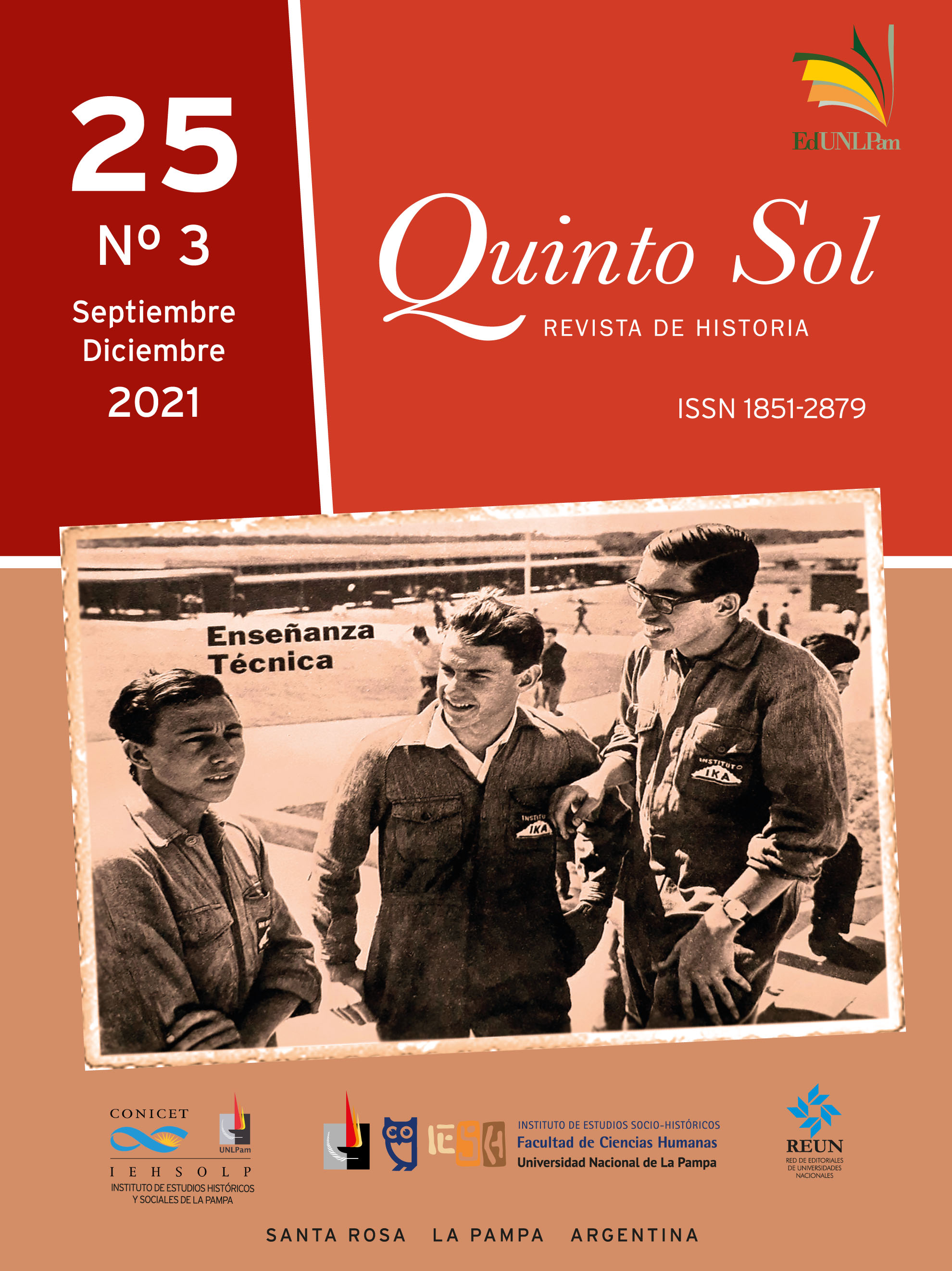Inimigos íntimos. Percepções do marxismo e as esquerdas em Tacuara e suas agrupações derivadas
DOI:
https://doi.org/10.19137/qs.v25i3.4381Palavras-chave:
identidade cultural, nacionalismo cultural, Tacuara, MarxismoResumo
O propósito deste artigo é compreender que lugar ocuparam as representações do marxismo e as esquerdas em Tacuara e suas agrupações derivadas, como parte de uma investigação mais ampla sobre os grupos católicos, marxistas, nacionalistas que se identificaram com a esquerda peronista nos anos sessenta. No texto, expõe-se que o marxismo e as esquerdas eram representados como uma alteridade radical com traços negativos, que operava como exterior constitutivo da própria identidade tacuarista. A teoria conspirativa do governo universal, ou a batalha cultural entre o cristianismo e o materialismo, não podiam funcionar sem o espectro do comunismo como ameaça permanente e multiforme. Por outro lado, os grupos nacionalistas queriam imitar a eficácia atribuída ao comunismo para infiltrar sociedades e colonizar consciências. Neste contexto, o conceito de luta de classes foi problematizado por Tacuara e incorporado depois por alguns de seus fraccionamentos o que evidencia o deslocamento de um nacionalismo culturista para outro mais secularizado. Para avançar nestas formulações se analisará a imprensa política de Taquara e suas agrupações derivadas, como Tacuara. Vocero De La Juventud Nacionalista, Ofensiva, Barricada Del Nacionalismo revolucionario, Tacuara del manchón e Nueva Argentina, entre outros documentos.
Downloads
Referências
Acha, O. (2014, 18 de septiembre). El peronismo y la forja del anticomunismo obrero [ponencia]. IV Congreso de Estudios sobre el Peronismo. Universidad Nacional de Tucumán, San Miguel de Tucumán, Argentina.
Bardini, R. (2002). Tacuara. La pólvora y la sangre. Océano.
Besoky, J. L. (2017). El discurso anticomunista en las publicaciones del peronismo de derecha. Claves. Revista de Historia, 3 (5), 129-153. https://doi.org/10.25032/crh.v3i5.156
Bohoslavsky, E. y Vicente, M. (2014). Sino el espanto: Temas, prácticas y alianzas de los anticomunismos de derecha en Argentina entre 1955 y 1966. Anuario del Instituto de Historia Argentina, 14, 1-17. https://www.anuarioiha.fahce.unlp.edu.ar/article
Bozza, J. A. (2016, 5 de diciembre). La sombra de la Revolución Cubana. Anticomunismo y nueva izquierda en la Argentina de los primeros años sesenta [ponencia]. IX Jornadas de Sociología de la Universidad Nacional de La Plata. La Plata, Argentina.
Campos, E. (2016). Entrevista a Alfredo Ossorio: de la derecha nacionalista a la izquierda peronista. En P. Pozzi (Coord.) Rebeldes e inconformistas. Procesos de politización y rebelión en América Latina (pp. 75-98). Imago Mundi.
Campos, E. (2019). De aristócratas revolucionarios a vanguardia de clase. La revisión del peronismo en Tacuara y sus agrupaciones derivadas. Prohistoria. Historia, políticas de la historia, 32, 155-181. https://doi.org/10.35305/prohistoria.vi.1107
Cuesta, M. (2011). Fragmento teológico-político de Walter Benjamin: una interpretación. Analecta. Revista de Humanidades, 5, 59-74.
Galván, M. V. (2008). El Movimiento Nacionalista Tacuara y sus agrupaciones derivadas: una aproximación desde la historia cultural [tesis de maestría, Universidad Nacional de General San Martín, tesis no publicada].
Galván, M. V. (2013). Militancia nacionalista en la era posperonista: las organizaciones Tacuara y sus vínculos con el peronismo. Nuevo Mundo Mundos Nuevos. https://doi.org/10.4000/nuevomundo.65364
Galván, M. V. (2014). Influencias de la Guerra Fría en el discurso nacionalista argentino. El retrato de los conflictos internacionales en el Semanario Nacionalista Azul y Blanco. OPSIS, 14, 205-224. https://doi.org/10.5216/o.v14iEspecial.30400
García Lupo, R. (1962). Diálogo con los jóvenes fascistas. En La rebelión de los generales. Proceso.
Georgieff, G. (2008). Nación y revolución. Itinerarios de una controversia en Argentina (1960-1970). Prometeo.
Goldar, E. (1972). La Revolución argelina. Centro Editor de América Latina.
González, H. (2007). Restos pampeanos: ciencia, ensayo y política en la cultura argentina del siglo XX. Colihue.
González Janzen, I. (1986). La Triple A. Contrapunto.
Gutman, D. (2003). Tacuara. Historia de la primera guerrilla urbana argentina. Vergara.
Jameson, F. (1995). La estética geopolítica. Cine y espacio en el sistema mundial. Paidós.
Noseto, L. (2014). Lecturas de Carl Schmitt. Forma y contenido de la teología política. Instituto de Investigaciones Gino Germani.
Padrón, J. M. (2017). ¡Ni yankis ni marxistas! Nacionalistas: Nacionalismo,
militancia y violencia política. El caso del Movimiento Nacionalista Tacuara
en la Argentina (1955-1966). Universidad Nacional de La Plata/Universidad Nacional de Misiones/Universidad Nacional de General Sarmiento.
Piglia, R. (2001). Plácidos domingos. Fundación Start.
Ruffini, M. (2016). Poder y violencia en Argentina durante la década de 1960. La trama del atentado al ex presidente Arturo Frondizi. Nuevo Mundo Mundos Nuevos. https://doi.org/10.4000/nuevomundo.69324
Schmitt, C. (2009). Teología política. Trotta.
Taguieff, P. (1993). El nacionalismo de los ‘nacionalistas’. Un problema para la historia de las ideas políticas en Francia. En G. Delanoi y P. Taguieff (Comps.) Teorías del nacionalismo (pp. 63-180). Paidós.
Taïeb, E. (2010). Logiques politiques du conspirationnisme. Sociologie et sociétés, 42 (2), pp. 265-289. https://doi.org/10.7202/045364ar
Downloads
Publicado
Edição
Seção
Licença
Al momento de enviar sus contribuciones, los colaboradores deberán declarar que poseen el permiso del archivo o repositorio donde se obtuvieron los documentos que se anexan al trabajo, cualquiera sea su formato (manuscritos inéditos, imágenes, archivos audiovisuales, etc.), permiso que los autoriza a publicarlos y reproducirlos, liberando a la revista y sus editores de toda responsabilidad o reclamo de terceros.
Asimismo, los autores deben adherir a la licencia Creative Commons denominada “Atribución - No Comercial CC BY-NC-SA”, mediante la cual el autor permite copiar, reproducir, distribuir, comunicar públicamente la obra y generar obras derivadas, siempre y cuando se cite y reconozca al autor original. No se permite, sin embargo, utilizar la obra con fines comerciales. Los autores podrán establecer acuerdos adicionales para la distribución no exclusiva de la versión de la obra publicada en la revista (por ejemplo, situarlo en un repositorio institucional o publicarlo en un libro), con el reconocimiento de haber sido publicado primero en esta revista.
La publicación de contenidos en esta revista no implica regalía ni cargo alguno para los/as contribuyentes.
Quinto Sol adhiere adhiere a DORA (Declaration on Research Assessment) firmada en San Francisco, California, el 16 de diciembre de 2012, y a la Declaración de México (Declaración Conjunta LATINDEX - REDALYC - CLACSO - IBICT).










4.png)
2.png)












_(2).png)


2.jpg)



1.jpg)





